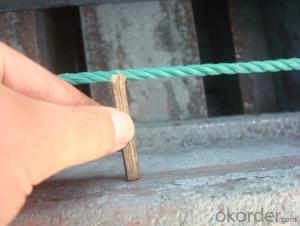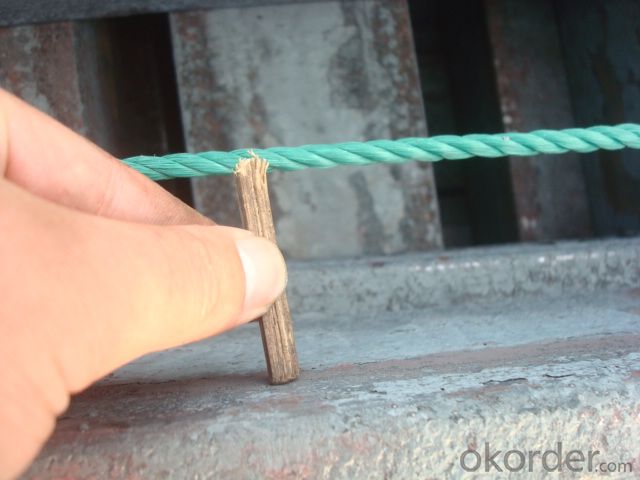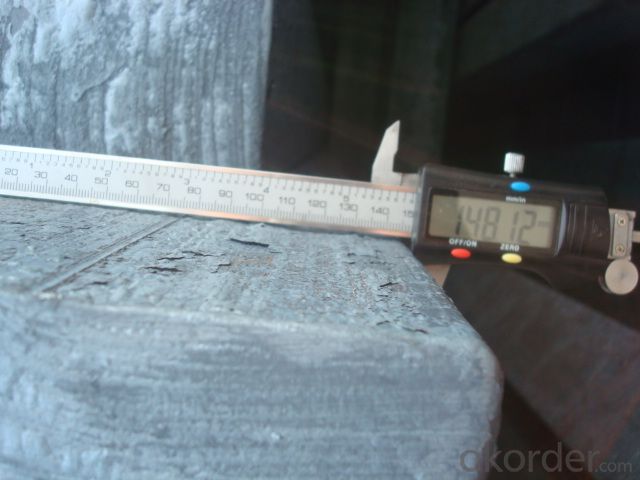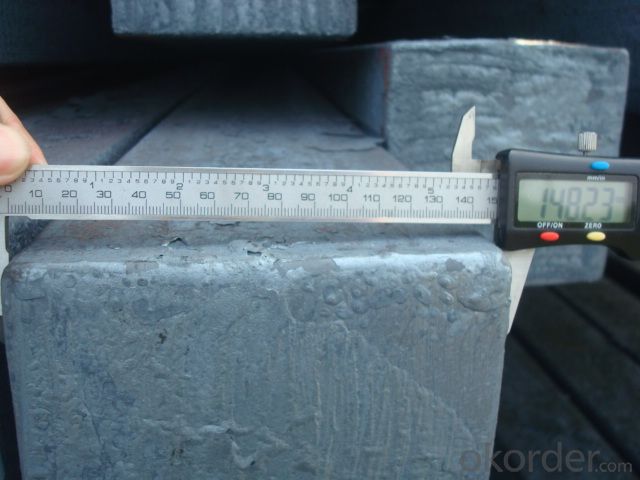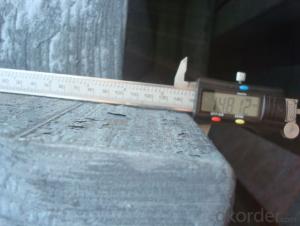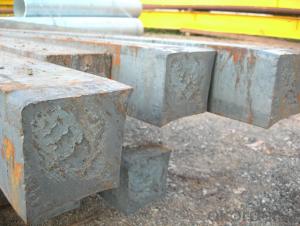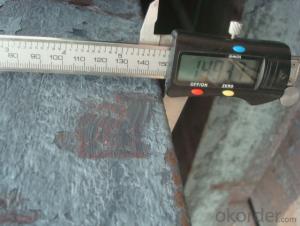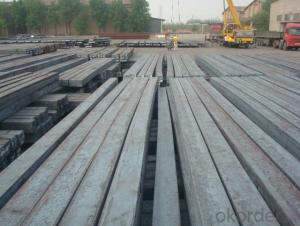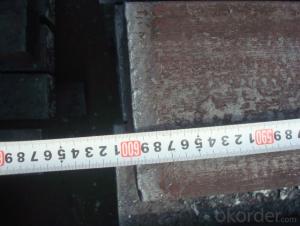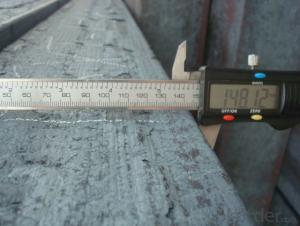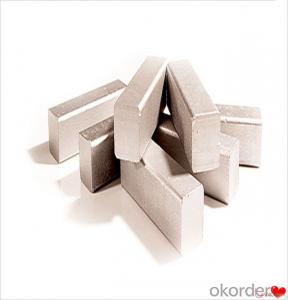Prime Steel Billet Q275, 20MnSi, 5SP,for very good price
- Loading Port:
- Tianjin
- Payment Terms:
- TT OR LC
- Min Order Qty:
- 1000 m.t.
- Supply Capability:
- 20000 m.t./month
OKorder Service Pledge
OKorder Financial Service
You Might Also Like
STEEL BILLET
1.Brief description
Steel billet(ingot) by cogging or breakdown of semi-finished products, is the raw material of all kinds of steel mill. Billet section of square, round, flat, rectangular and abnormity of several kinds of, mainly related to the shape of rolled products.
2.Features
Rectangular billet continuous casting billet and mainly general carbon steel, low carbon low silicon cold-rolled material, high quality carbon structural steel, high strength low alloy steel, special steel, etc.
The billet is mainly divided into two kinds from the shape:
Slab: cross section width and height of the ratio of the larger, mainly used for rolling plate.
Billet: equal cross section width and height, or a huge difference, mainly used for rolling steel, wire rod. ,
Steel billets have distinct characteristics as compared with already furnished steel bars and products. Billets have a specific grain structure, which enables the metal to be processed more intricately. Steel billets are also known for their malleability and ductility, especially when exposed to varying temperatures during shaping and molding.
3.Processing
Steel billets are considered fresh and raw, and they must undergo a series of manufacturing processes before they can be used for various purposes. Billets are made by means of freezing molten liquid, and are later exposed to extremely low temperatures in order to allow the metal to take shape and solidify in chemical structure. The temperature manipulates the metal's physical properties, and tones its strength and durability. The subsequent processes provide the metal's curved mold design so that it can fit the allotted space provided by other machines, which complete the finishing procedures.
4.Pictures
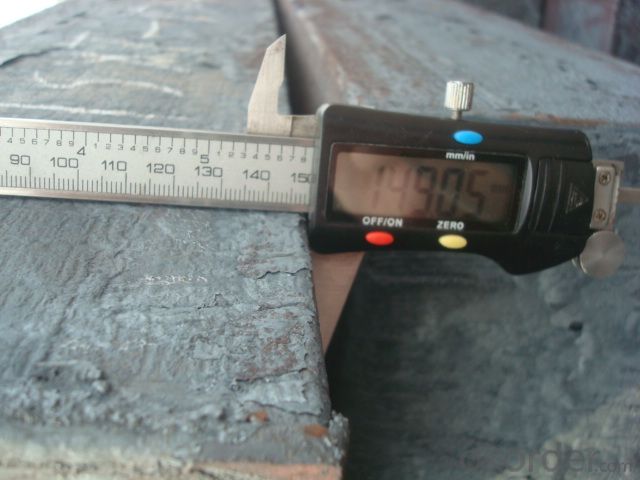
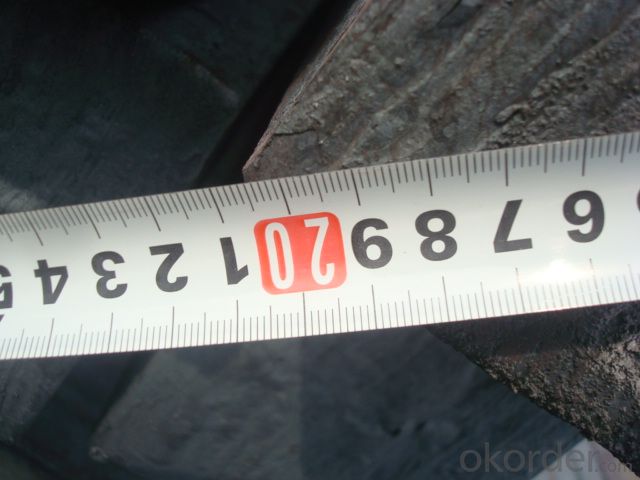
5.Usage
Billets, or ingots (as they sometimes referred to), are not of practical use until they have been formed into more functional shapes and sizes. While they have already been put in the furnace, they still require a series of shaping and molding procedures such as hot and cold working, milling and cutting before they are sold in hardware stores, or used for different applications. The unformed billets, however, can be used in striking currency such as coins and as reserves, similar to gold bars.
6.Detailed specification
Hot rolled billet steel
Size: 50x50mm-180x180mm
Steel Grade: 3SP, 5SP,Q195,Q235,Q255,Q275 Length:3m-12m
MOQ: 1000MT/size
Payment term: TT or LC
Packing: in bulk , bundle
Shipment: by container , bulk vessel
Packaging Details: bundles with steel strips or as customers's requirements
Delivery time: 15-30 days after the deposit
Loading port:Tianjin, or other port China
Origin : China
Inspection:Third party inspection before loading.
- Q: Are there any international standards for steel billets?
- Yes, there are international standards for steel billets. The International Organization for Standardization (ISO) has developed several standards that define the requirements and specifications for steel billets. The most commonly used ISO standard for steel billets is ISO 683-2, which specifies the technical delivery requirements for hot-rolled steel bars, sections, and billets for general engineering purposes. Additionally, the American Society for Testing and Materials (ASTM) has also developed standards for steel billets, such as ASTM A615/A615M, which specifies the requirements for deformed and plain carbon-steel bars for concrete reinforcement. These international standards ensure that steel billets produced and traded globally meet the necessary quality and performance criteria, promoting consistency and compatibility in the industry.
- Q: What are the common defects in steel billets during hot rolling?
- Certain defects may be experienced by steel billets during hot rolling, which could potentially impact the quality of the final product. Some commonly encountered defects include: 1. Longitudinal surface cracks: These cracks appear on the surface of the billet and may occur due to inadequate cooling, high rolling temperatures, or inferior steel quality. Surface cracks can compromise the structural integrity and performance of the product. 2. Internal cracks: These cracks are found within the billet, away from the surface. They can be caused by insufficient billet heating, uneven temperature distribution, or improper rolling parameters. Internal cracks may lead to material failure or inconsistencies in the final product's dimensions. 3. Surface defects: These defects encompass scales, pits, or scars on the surface of the billet. They are often a consequence of subpar billet preparation, inadequate scale removal, or improper rolling techniques. Surface defects can impact the appearance and surface quality of the final product. 4. Lamination: Lamination defects manifest when there are layers or separations within the billet. They can be caused by impurities in the steel, improper billet preparation, or inadequate rolling parameters. Laminations can result in diminished mechanical properties and compromised structural integrity of the final product. 5. Warping: Warping defects occur when the billet experiences uneven cooling or excessive rolling tensions. This can cause distortion or bending of the billet, leading to inconsistencies in the final product's dimensions. 6. Inclusions: Inclusions refer to non-metallic particles or impurities that become trapped within the steel during the billet formation process. They can lead to reduced mechanical properties, surface defects, or material failure in the final product. To mitigate these defects, it is crucial to exercise proper control over rolling parameters, billet preparation, and cooling processes. Regular inspections and the implementation of quality control measures should be employed to detect and address any defects that may arise during hot rolling.
- Q: What are the main factors affecting the quality of steel billets?
- There are several main factors that can significantly affect the quality of steel billets. These factors include the composition of the steel, the temperature and time of the heating process, the cooling rate, and the presence of impurities. Firstly, the composition of the steel plays a crucial role in determining its quality. The presence of certain elements such as carbon, manganese, and silicon can affect the mechanical properties of the steel, including its strength and hardness. The proper control and balance of these alloying elements are essential to ensure the desired quality of the steel billets. Secondly, the temperature and time of the heating process during the production of steel billets are critical factors. The heating process must be carefully controlled to achieve the optimal temperature for the desired transformation of the microstructure. Overheating or underheating can lead to the formation of undesirable phases or an inconsistent microstructure, which can negatively impact the quality of the billets. The cooling rate is another important factor affecting the quality of steel billets. The cooling process needs to be controlled to achieve the desired microstructure and mechanical properties. Too rapid cooling can result in the formation of brittle phases or residual stresses, while slow cooling can lead to coarse-grained structures with reduced strength. Furthermore, the presence of impurities in the steel can significantly affect its quality. Impurities such as sulfur, phosphorus, and non-metallic inclusions can decrease the mechanical properties and promote the formation of defects in the steel billets. Therefore, strict control of the raw materials and the implementation of effective refining techniques are necessary to minimize the presence of impurities. In conclusion, the main factors affecting the quality of steel billets are the composition of the steel, the temperature and time of the heating process, the cooling rate, and the presence of impurities. By carefully controlling and optimizing these factors, steel manufacturers can produce high-quality billets that meet the desired specifications and performance requirements.
- Q: What are the main challenges in the recycling of steel billets?
- Several challenges arise when it comes to recycling steel billets, which are semi-finished steel products. The recycling process of steel billets includes several main challenges: 1. Contamination: Throughout their usage, steel billets can become contaminated with various materials such as oil, grease, paint, or other metals. Removing these contaminants and ensuring the purity of the recycled steel can be a complex and costly process. 2. Sorting and segregation: Steel billets come in different grades and sizes, requiring them to be sorted and segregated accordingly for effective recycling. This necessitates advanced sorting technologies and manual labor to ensure that the correct billets are recycled in the appropriate manner. 3. Energy consumption: The recycling of steel billets involves melting and reprocessing the steel, which demands a significant amount of energy. This energy consumption presents a challenge as it contributes to greenhouse gas emissions and increases the overall environmental impact of the recycling process. 4. Infrastructure and logistics: The collection, transportation, and processing of steel billets necessitate a well-established infrastructure and logistics network. Insufficient facilities or transportation can impede the efficient recycling of steel billets. 5. Economic viability: The economic viability of recycling steel billets can be challenging, especially when the cost of recycling exceeds the value of the recycled material. This can discourage recycling efforts and lead to a greater reliance on primary steel production. 6. Consumer awareness and participation: It is crucial to educate consumers about the importance of recycling steel billets and encourage their participation in recycling programs. Lack of awareness and indifference towards recycling can hinder the collection of steel billets for recycling purposes. 7. International trade barriers: In certain cases, trade barriers and import/export restrictions can affect the recycling of steel billets. These barriers can limit the flow of recycled steel billets across different countries, impacting the overall recycling capacity and market dynamics. To address these challenges, a collaborative effort between industries, governments, and consumers is necessary. Investments in research and development, technological advancements, and policy support can help overcome these challenges and promote the sustainable recycling of steel billets.
- Q: What are the common surface treatments for steel billets?
- Steel billets can undergo several surface treatments to improve performance and protect against corrosion. Common treatments include: 1. Hot-dip galvanizing: Immersing billets in molten zinc creates a protective coating, offering excellent corrosion resistance for outdoor applications. 2. Electroplating: Passing an electric current through a metal ion solution deposits metals like nickel, chromium, or zinc onto billet surfaces, providing desired properties and appearance. 3. Powder coating: Spraying dry powder onto billet surfaces and heating it forms a durable, chemical-resistant coating. This method offers various color options and UV radiation protection. 4. Phosphating: Applying a phosphate coating improves corrosion resistance and promotes paint adhesion, suitable for subsequent painting or powder coating. 5. Blackening: Applying a chemical solution creates a black oxide layer, enhancing appearance and providing mild corrosion resistance for decorative purposes. 6. Passivation: Treating billets with an acid solution removes contaminants and creates a passive oxide layer, improving corrosion resistance, especially for stainless steel billets. These treatments are widely used in industries to enhance billet properties and lifespan. The choice depends on specific requirements, including application, appearance, and environmental conditions.
- Q: How are steel billets tested for strength and durability?
- To ensure the strength and durability of steel billets, rigorous examinations and tests are conducted. The objective is to verify that the billets possess the necessary properties to withstand their intended application and perform optimally in diverse conditions. The tensile strength test is a key evaluation performed on steel billets. This involves gradually increasing the axial load on the billet until it reaches its breaking point. By measuring the applied force and resulting deformation, the ultimate tensile strength can be determined. This test assesses the steel's ability to resist external forces and provides vital information about its structural integrity. Another crucial assessment is the hardness test, which measures the steel billet's resistance to indentation or scratching. Various methods, such as the Brinell, Rockwell, or Vickers hardness tests, can be used to determine the hardness value. This information helps evaluate the billet's resistance to wear, deformation, and potential damage. Heat treatment is also vital in testing the strength and durability of steel billets. This process involves controlled heating and cooling cycles to modify the billets' microstructure, resulting in improved mechanical properties. By carefully monitoring temperature, time, and cooling rate during heat treatment, desired properties like increased strength and toughness can be achieved. Furthermore, non-destructive testing techniques, like ultrasonic testing, magnetic particle inspection, and radiographic examination, are employed to assess internal quality and identify any potential defects or flaws in the billets. These methods provide valuable information about the billet's structural soundness, ensuring it meets required standards and specifications. Additionally, chemical composition analysis is conducted to verify the elemental composition of the steel billets. This analysis ensures that the alloying elements are within specified limits, as they significantly affect mechanical properties. Any deviation from the required composition could compromise strength and durability. In conclusion, steel billets undergo a comprehensive series of tests and evaluations to ensure strength and durability. These include tensile strength testing, hardness testing, heat treatment, non-destructive testing, and chemical composition analysis. By subjecting the billets to these assessments, manufacturers can guarantee the quality of their steel products, ensuring they meet the demanding requirements of various applications.
- Q: What are the main factors affecting the corrosion resistance of alloy steel billets?
- The corrosion resistance of alloy steel billets is influenced by several key factors. Firstly, the composition of the alloy steel plays a crucial role in determining its resistance to corrosion. Alloy steels containing a higher percentage of elements such as chromium, nickel, and molybdenum tend to have enhanced corrosion resistance compared to steels with lower alloy content. Secondly, the presence of protective surface coatings or finishes can significantly improve the corrosion resistance of alloy steel billets. Various coatings, such as zinc or epoxy, act as a barrier between the metal surface and the corrosive environment, preventing the steel from coming into direct contact with corrosive agents. Additionally, the manufacturing process used to produce alloy steel billets can impact their corrosion resistance. Proper heat treatment and quenching processes can enhance the microstructure of the alloy, creating a more corrosion-resistant material. The environment in which the alloy steel billets are exposed is another crucial factor. Factors such as temperature, humidity, pH levels, and the presence of corrosive substances can all influence the corrosion resistance of the alloy steel billets. For example, exposure to high temperatures or acidic environments can accelerate corrosion, while exposure to dry or neutral conditions may have a minimal impact on corrosion resistance. Lastly, the design and maintenance of structures or equipment made from alloy steel billets can affect their corrosion resistance. Proper design considerations, such as avoiding sharp corners or crevices where moisture can accumulate, can help minimize the risk of corrosion. Regular inspection, cleaning, and maintenance can also help prevent corrosion by identifying and addressing any issues promptly. In conclusion, the main factors affecting the corrosion resistance of alloy steel billets include the composition of the steel, the presence of protective coatings, the manufacturing process, the environmental conditions, and the design and maintenance practices. By considering these factors, manufacturers and users can ensure that alloy steel billets exhibit optimal corrosion resistance in various applications.
- Q: What is the average lead time for ordering steel billets?
- The lead time for ordering steel billets can vary depending on several factors, including the supplier, quantity needed, production capacity, and current market conditions. Typically, the lead time can range from a few weeks to a couple of months. If the supplier has readily available stock or a short production cycle, the lead time may be shorter, usually around two to four weeks. However, if the supplier needs to produce the steel billets specifically for the order, it may take longer. In such cases, the lead time can extend to six to eight weeks or even longer, particularly if there are any production process delays. Considering the quantity required is also crucial. Smaller orders may have shorter lead times compared to larger quantities, as they can be accommodated within the supplier's existing production schedule or available stock. Furthermore, market conditions play a significant role. When there is high demand or disruptions in the supply chain, lead times may increase due to heightened competition for resources and longer production cycles. To obtain an accurate estimate of the average lead time for ordering steel billets, it is advisable to contact multiple suppliers and discuss your specific requirements with them. They can provide more precise information based on their production capabilities and the current market conditions.
- Q: What are the different methods of steel billet surface plating?
- There are several methods of steel billet surface plating, including electroplating, hot-dip galvanizing, mechanical plating, and chemical plating. Each method offers specific advantages and is used depending on the requirements of the application. Electroplating involves the deposition of a thin layer of metal onto the steel surface through an electric current. Hot-dip galvanizing immerses the steel billet into a bath of molten zinc to create a protective coating. Mechanical plating utilizes mechanical energy to bond a metal coating onto the steel surface. Chemical plating involves a chemical reaction to deposit a metal coating onto the billet surface.
- Q: What are the main factors affecting the impact toughness of steel billets?
- The main factors affecting the impact toughness of steel billets include the composition of the steel, the heat treatment process, the presence of impurities or defects, the grain size and microstructure, and the temperature at which the impact test is conducted.
Send your message to us
Prime Steel Billet Q275, 20MnSi, 5SP,for very good price
- Loading Port:
- Tianjin
- Payment Terms:
- TT OR LC
- Min Order Qty:
- 1000 m.t.
- Supply Capability:
- 20000 m.t./month
OKorder Service Pledge
OKorder Financial Service
Similar products
Hot products
Hot Searches
Related keywords
